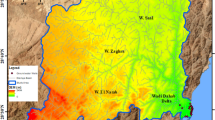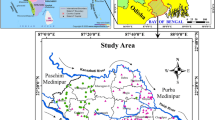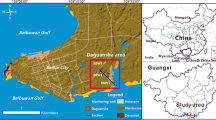Abstract
Hydrogeochemical processes that accompany seawater intrusion in coastal aquifers can alter the resulting water quality and are important ingredients in coastal aquifer management. The presence of dissolution–precipitation reactions and ion exchange in the mixing zone of the Biscayne aquifer (FL, USA) are suggested based on changes in major ion concentrations and mineral saturation indices (SI). Major ion concentrations from 11 groundwater samples are compared with theoretical mixing between freshwater and seawater. PHREEQC code was used to calculate saturation indices of the samples with respect to common phases in the Biscayne aquifer. High Ca2+ and HCO3 − content of the samples is typical of waters in contact with carbonate aquifers. Water quality of the samples is mainly attributed to mixing and precipitation–dissolution reactions with calcite and dolomite. The samples were saturated with calcite (SI ~ 0) and undersaturated for dolomite (SI < 0), while a few samples showed dolomite saturation. Because gypsum and halite SI could be predicted by theoretical mixing, reactions with those minerals, if present, are thought to be insignificant. In the active intrusion areas, cation exchange also appears to modify water quality leading to excess Ca2+, but depleted Na+, Mg2+ and K+ concentrations. On the other hand, samples from previous intrusion areas plotted very close to the theoretical mixing line and approached equilibrium with the seawater.




Similar content being viewed by others
References
Appelo C (1994) Cation and proton exchange, pH variations, and carbonate reactions in a freshening aquifer. Water Resour Res 30:2793–2805
Appelo CAJ, Postma D (2010) Geochemistry, groundwater and pollution, 2nd edn. Taylor & Francis, Amsterdam
Back W, Hanshaw BB, Herman JS, Van Driel JN (1986) Differential dissolution of a Pleistocene reef in the ground-water mixing zone of coastal Yucatan, Mexico. Geology 14:137–140
Barlow PM, Reichard EG (2010) Saltwater intrusion in coastal regions of North America. Hydrogeol J 18:247–260
Bear J, Cheng AHD, Sorek S, Ouazar D, Herrera I (1999) Seawater intrusion in coastal aquifers: concepts, methods and practices. Kluwer Academic Publishers, Amsterdam
Bradner A, McPherson BF, Miller RL, Kish G, Bernard B (2005) Quality of ground water in the biscayne aquifer in miami-dade, broward, and palm beach counties, Florida, 1996–1998, with emphasis on contaminants. US Geol Surv Open-File Rep 2004–1438:20
Cooper HH, Kohout FA, Henry HR, Glover RE (1964) Sea water in coastal aquifers. US Geol Surv Water-Suppl Pap 1613-C, 84
Cunningham KJ (2004) Characterization of aquifer heterogeneity using cyclostratigraphy and geophysical methods in the upper part of the karstic Biscayne aquifer, southeastern Florida. US Geol Surv Water Resour Invest Rep 03-4208, 66
Cunningham KJ, Wacker MA, Robinson E, Dixon JF, Wingard GL (2006) A cyclostratigraphic and borehole-geophysical approach to development of a three-dimensional conceptual hydrogeologic model of the karstic Biscayne aquifer, southeastern Florida. US Geol Surv Sci Invest Rep 2005–5235:69
Dausman A, Langevin CD (2005) Movement of the saltwater interface in the surficial aquifer system in response to hydrologic stresses and water-management practices, Broward County, Florida. US Geol Surv Sci Invest Rep 2004–5256:1–73
Fish JE, Stewart MT (1991) Hydrogeology of the surficial aquifer system, Dade County, Florida. US Geol Surv Water Resour Invest Rep 90-4108
Ghiglieri G, Carletti A, Pittalis D (2012) Analysis of salinization processes in the coastal carbonate aquifer of Porto Torres (NW Sardinia, Italy). J Hydrol 432:43–51
Gimenez E, Morell I (1997) Hydrogeochemical analysis of salinization processes in the coastal aquifer of Oropesa (Castellon, Spain). Environ Geol 29:118–131
Harvey RW, Metge DW, Shapiro AM, Renken RA, Osborn CL, Ryan JN, Cunningham KJ, Landkamer L (2008) Pathogen and chemical transport in the karst limestone of the Biscayne aquifer: 3. Use of microspheres to estimate the transport potential of Cryptosporidium parvum oocysts. Water Resour Res 44:W08431
Hem JD (1985) Study and interpretation of the chemical characteristics of natural water. US Geol Surv Water-Suppl Pap 2254
Klein H, Waller B (1984) Synopsis of saltwater intrusion in Dade County, Florida, through 1984. US Geol Surv Water-Res Invest Rep 85–4101:1
Kohout F (1960) Cyclic flow of salt water in the Biscayne aquifer of southeastern Florida. J Geophys Res 65:2133–2141
Kouzana L, Mammou AB, Felfoul MS (2009) Seawater intrusion and associated processes: case of the Korba aquifer (Cap-Bon, Tunisia). C R Geosci 341:21–35
Langevin CD, Zygnerski M (2013) Effect of sea-level rise on salt water intrusion near a coastal well field in Southeastern Florida. Groundwater 51:781–803
Marella RL (2009) Water withdrawals, use, and trends in Florida, 2005. US Geol Surv Sci Invest Rep 2009–5125:1–49
Parkhurst DL, Appelo C (2013) Description of input and examples for PHREEQC version 3: a computer program for speciation, batch-reaction, one-dimensional transport, and inverse geochemical calculations. US Geol Surv Tech Methods, book 6, chap. A-43, 497
Peters CJ (2008) Saltwater Intrusion Monitoring in the Biscayne Aquifer near Florida City, Miami-Dade County, Florida: 1996–2007. Proceedings of 20th SWIM, 195–198
Plummer L, Vacher H, Mackenzie F, Bricker O, Land L (1976) Hydrogeochemistry of Bermuda: a case history of ground-water diagenesis of biocalcarenites. Geol Soc Am Bull 87:1301–1316
Price RM (2001) Geochemical determinations of groundwater flow in Everglades National Park. PhD Dissertation, University of Miami, Coral Gables, FL, 235
Price RM, Herman JS (1991) Geochemical investigation of salt-water intrusion into a coastal carbonate aquifer: Mallorca, Spain. Geol Soc Am Bull 103:1270–1279
Prinos ST, Wacker MA, Cunningham KJ, Fitterman DV (2014) Origins and delineation of saltwater intrusion in the biscayne aquifer and changes in the distribution of Saltwater in Miami-Dade County, Florida. US Geol Surv Sci Invest Rep 2014–5025:101p
Pulido-Leboeuf P (2004) Seawater intrusion and associated processes in a small coastal complex aquifer (Castell de Ferro, Spain). Appl Geochem 19:1517–1527
Reese RS, Cunningham KJ (2000) Hydrogeology of the gray limestone aquifer in southern Florida. US Geol Surv Water Resour Invest Rep 99-4213, 244
Renken R, Cunningham K, Zygnerski M, Wacker M, Shapiro A, Harvey R, Metge D, Osborn C, Ryan J (2005) Assessing the vulnerability of a municipal well field to contamination in a karst aquifer. Environ Eng Geosci 11:319–331
Renken RA, Cunningham KJ, Shapiro AM, Harvey RW, Zygnerski MR, Metge DW, Wacker MA (2008) Pathogen and chemical transport in the karst limestone of the Biscayne aquifer: 1. Revised conceptualization of groundwater flow. Water Resour Res 44:399–416
Rezaei M, Sanz E, Raeisi E, Ayora C, Vázquez-Suñé E, Carrera J (2005) Reactive transport modeling of calcite dissolution in the fresh-salt water mixing zone. J Hydrol 311:282–298
Romanov D, Dreybrodt W (2006) Evolution of porosity in the saltwater–freshwater mixing zone of coastal carbonate aquifers: an alternative modelling approach. J Hydrol 329:661–673
Russak A, Sivan O (2010) Hydrogeochemical tool to identify salinization or freshening of coastal aquifers determined from combined field work, experiments, and modeling. Environ Sci Technol 44:4096–4102
Sanford WE, Konikow LF (1989) Simulation of calcite dissolution and porosity changes in saltwater mixing zones in coastal aquifers. Water Resour Res 25:655–667
Sanz E, Ayora C, Carrera J (2011) Calcite dissolution by mixing waters: geochemical modeling and flow-through experiments. Geol Acta 9:67–77
Sivan O, Yechieli Y, Herut B, Lazar B (2005) Geochemical evolution and timescale of seawater intrusion into the coastal aquifer of Israel. Geochim Cosmochim Acta 69:579–592
Smart P, Dawans J, Whitaker F (1988) Carbonate dissolution in a modern mixing zone. Nature 335:811–813
Sonenshein RS (1997) Delineation and extent of saltwater intrusion in the Biscayne Aquifer, eastern Dade County, Florida, 1995. US Geol Surv Water Resour Invest Rep 96-4285, 1
Stoessell R, Ward W, Ford B, Schuffert J (1989) Water chemistry and CaCO3 dissolution in the saline part of an open-flow mixing zone, coastal Yucatan Peninsula, Mexico. Geol Soc Am Bull 101:159–169
Swayze LJ (1980) Water-level contour and salt-front map, hialeah-miami springs well field area, Dade County, Florida, October 13, 1978. US Geol Surv Open-File Rep 80–8:1
Werner AD, Bakker M, Post VE, Vandenbohede A, Lu C, Ataie-Ashtiani B, Simmons CT, Barry DA (2013) Seawater intrusion processes, investigation and management: recent advances and future challenges. Adv Water Resour 51:3–26
Wicks CM, Herman JS, Randazzo AF, Jee JL (1995) Water-rock interactions in a modern coastal mixing zone. Geol Soc Am Bull 107:1023–1032
Wigley T, Plummer L (1976) Mixing of carbonate waters. Geochim Cosmochim Acta 40:989–995
Acknowledgments
The authors acknowledge funding provided by Florida International University, through a Presidential Fellowship and a Research Assistantship.
Author information
Authors and Affiliations
Corresponding author
Rights and permissions
About this article
Cite this article
Habtemichael, Y.T., Fuentes, H.R. Hydrogeochemical Analysis of Processes Through Modeling of Seawater Intrusion Impacts in Biscayne Aquifer Water Quality, USA. Aquat Geochem 22, 197–209 (2016). https://doi.org/10.1007/s10498-016-9287-1
Received:
Accepted:
Published:
Issue Date:
DOI: https://doi.org/10.1007/s10498-016-9287-1




